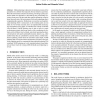100
click to vote
JAIR
2008
15 years 1 months ago
2008
We represent planning as a set of loosely coupled network flow problems, where each network corresponds to one of the state variables in the planning domain. The network nodes cor...
128
click to vote
JAIR
2008
15 years 1 months ago
2008
Multi-robot path planning is difficult due to the combinatorial explosion of the search space with every new robot added. Complete search of the combined state-space soon intracta...
84
Voted
IJRR
2008
15 years 1 months ago
2008
In this paper we discuss the problem of planning safe paths amidst unpredictably moving obstacles in the plane. Given the initial positions and the maximum speeds of the moving ob...
131
Voted
IJHR
2008
15 years 1 months ago
2008
Motion planning for humanoids faces several challenging issues: high dimensionality of the configuration space, necessity to address balance constraints in single and double suppo...
111
click to vote
AUTOMATICA
2006
15 years 1 months ago
2006
In this paper we show that the problem of optimal mine planning can be cast in the framework of receding horizon control. Traditional formulations of this problem have cast it in ...
103
click to vote
ASE
2006
15 years 1 months ago
2006
The structured programming literature provides methods and a wealth of heuristic knowledge for guiding the construction of provably correct imperative programs. We investigate the...
131
Voted
AUTOMATICA
2007
15 years 1 months ago
2007
In this work we present a methodology for intelligent path planning in an uncertain environment using vision like sensors, i.e., sensors that allow the sensing of the environment ...
124
Voted
AI
2010
Springer
15 years 1 months ago
2010
Springer
Case-based planning can take advantage of former problem-solving experiences by storing in a plan library previously generated plans that can be reused to solve similar planning p...
111
Voted
AI
2008
Springer
15 years 1 months ago
2008
Springer
The current best conformant probabilistic planners encode the problem as a bounded length CSP or SAT problem. While these approaches can find optimal solutions for given plan leng...
136
Voted
ECAI
2010
Springer
15 years 1 months ago
2010
Springer
Motion planning in dynamic environments consists of the generation of a collision-free trajectory from an initial to a goal state. When the environment contains uncertainty, preven...



